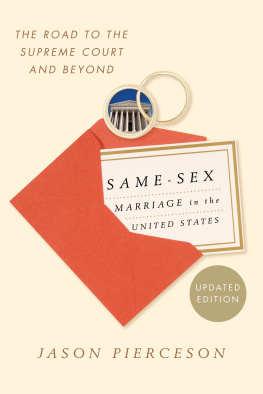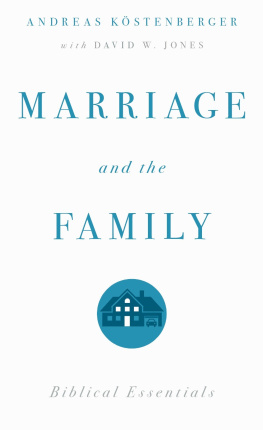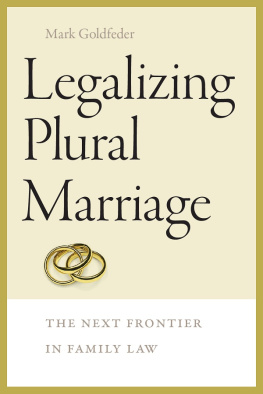Same-Sex Marriage in the United States
Same-Sex Marriage in the United States
The Road to the Supreme Court
Jason Pierceson
ROWMAN & LITTLEFIELD PUBLISHERS, INC.
Lanham Boulder New York Toronto Plymouth, UK
Published by Rowman & Littlefield Publishers, Inc.
A wholly owned subsidiary of The Rowman & Littlefield Publishing Group, Inc.
4501 Forbes Boulevard, Suite 200, Lanham, Maryland 20706
www.rowman.com
10 Thornbury Road, Plymouth PL6 7PP, United Kingdom
Copyright 2013 by Rowman & Littlefield Publishers, Inc.
First paperback edition 2014
All rights reserved. No part of this book may be reproduced in any form or by any electronic or mechanical means, including information storage and retrieval systems, without written permission from the publisher, except by a reviewer who may quote passages in a review.
British Library Cataloguing in Publication Information Available
Library of Congress Cataloging-in-Publication Data
The hardback edition of this book was previously cataloged by the Library of Congress as follows:
Pierceson, Jason, 1972
Same-sex marriage in the United States : the road to the Supreme Court / Jason Pierceson.
pages cm
Includes index.
1. Same-sex marriageUnited States. 2. Same-sex marriageLaw and legislationUnited States. I. Title.
HQ1034.U5P54 2013
306.84'80973dc23
2012049870
ISBN 978-1-4422-1204-6 (hbk. : alk. paper)
ISBN 978-1-4422-1205-3 (pbk. : alk. paper)
ISBN 978-1-4422-1206-0 (electronic)
 The paper used in this publication meets the minimum requirements of American National Standard for Information Sciences Permanence of Paper for Printed Library Materials, ANSI/NISO Z39.48-1992.
The paper used in this publication meets the minimum requirements of American National Standard for Information Sciences Permanence of Paper for Printed Library Materials, ANSI/NISO Z39.48-1992.
Printed in the United States of America
To Dylan White
Preface
This book explores legal, political, and cultural factors behind the movement for marriage equality in the United States and the opposition to that movement with the goal of placing eventual action by the U.S. Supreme Court in context. It also examines the history of the movement for marriage equality, explores the ideas behind the movement and its opposition, and places developments in the United States in a comparative context. It is intended to be accessible and useful for scholars of law and politics, and students and citizens interested in the topic.
The book is the product of significant support and assistance. The Center for State Policy and Leadership at the University of Illinois, Springfield, provided financial support for the research and writing of the book, and I thank David Racine and others in the Center for seeing promise in this project. I thank Fulbright Canada and the Alberta Institute for American Studies and the Faculty of Law at the University of Alberta for providing support. Thanks also to Jonathan Sisk and the great staff at Rowman & Littlefield, as well as the reviewers of the manuscript, for working with me in seeing the project through to completion. Finally, thank you to Dylan White for supporting me in innumerable ways, and especially for his patience. It is not easy completing large scholarly projects while at a teaching institution, and this book would not have been possible without his support and encouragement.
Chapter 1
Introduction
The issue of same-sex marriage has become one of the defining social issues in contemporary U.S. politics. State court decisions finding in favor of same-sex relationship equality claims have been central to the issues ascent from nowhere to near the top of the national political agenda, starting with Hawaii in 1993 and continuing through the fight over Proposition 8 in California and the legalization of same-sex marriage in New York. Indeed, the fact that the California court found same-sex marriage to be a fundamental right and applied the highest level of equal protection review, strict scrutiny, in ordering same-sex marriage in the state illustrates how far the jurisprudence has evolved on this question in the last fifteen years.
There is a clear story of jurisprudential evolution from Hawaii, through Vermont, Massachusetts, New Jersey, California, Connecticut, and, remarkably, Iowa. This is also illustrated by the fact that trial court judges are increasingly willing to find in favor of same-sex marriage claimsa policy innovation role that this type of judge seldom plays. However, the same federalism that has allowed this policy innovation from courts has led to a pronounced backlash in states not wishing to be a part of this change, including Proposition 8, which banned same-sex marriage in California, the challenge to which has created a new phase in the legal and political context of same-sex marriage. Federal courts have invalidated Prop. 8, setting the stage, along with the striking down of the federal Defense of Marriage Act by federal courts, for ultimate review by the U.S. Supreme Court.
This book will tell the story of this legal and cultural shift and its backlash in order to set the stage for Supreme Court action. Rather than simply focus on jurisprudence, the book will pay special attention to the complex and interactive relationship between law and politics. Indeed, it is a fundamental assumption of this book that politics both shapes and is shaped by law. In other words, in order to understand how the Supreme Court will deal with the issue of same-sex marriage, it is necessary to fully explore the legal, political, and cultural evolution of the issue and the interaction between law and politics.
An example from the heart of the country illustrates the complex dynamics involved. In 2009, the Iowa Supreme Court unanimously ruled that the states statute prohibiting same-sex marriage was unconstitutional. As a consequence, same-sex marriage became legal in Iowa later that year. Polls taken before and after the decision, however, indicated less-than-majority support for same-sex marriage in the state. In other words, the courts constitutional interpretation did not match the policy preferences of the citizens, as reflected in opinion polls. Democrats in the state, who held majorities in the legislature and the office of governor, were able to rebuff attempts by conservative Republicans to reverse the decision through a constitutional amendment. However, the 2010 election became a referendum on the Supreme Court decision, with the significant presence of same-sex marriage in the race for governor (the Democratic incumbent, Chet Culver, was challenged by former Republican governor, Terry Branstad) and in retention elections of three of the seven justices who ruled in favor of same-sex marriage.
In a gubernatorial debate, the candidates articulated the two sides of the debate over same-sex marriage and the role of the courts. Responding to a question, from a legally married lesbian couple with children, about why their marriage should not be legal, Terry Branstad stated,
I believe that the law, passed by the legislature and signed by me [when he was formerly governor], was appropriate, and that is to limit marriage between one man and one woman. The [Iowa] Supreme Court has struck that down, and I think the people of Iowa deserve the same opportunity as they have in thirty-one other states: vote on this critical issue. In all thirty-one states, from Maine to California, where its come up for a vote people have restored one-man-one-woman-marriage in the [state] constitution. Im a Catholic, and I believe in traditional marriage. I believe that we, the people of Iowa, should have the opportunity to vote on that issue.
Politicians as experienced as Branstad, the former governor, are good at sending signals to multiple constituencies or emphasizing themes that will be attractive to a range of voters. Indeed, in a few brief sentences, Branstad hit upon several of the arguments against same-sex marriage, arguments more fully explored in the following chapters. First, he makes an argument against judicial activism and argues that issues of civil rights and equality should be open to popular vote, not the courts. This is a particularly strong political tactic to get votes, especially when the civil rights are those of a relatively small minority. Second, he notes the significant backlash that same-sex marriage legalization has engendered, putting him and his voters on the side of majority rule. Third, by twice referencing one man, one woman marriage, he references the argument that same-sex marriage will open the door to plural marriage. Finally, he invokes his religion, knowing that opposition to same-sex marriage is an issue that unites Catholics and Protestants, showing his Catholicism to be an asset in this mostly Protestant state and signaling to religious conservatives that he is one of them. Indeed, religion looms large over this issue and is the most significant source of political opposition to same-sex marriage. Of course, religious voices and perspectives supporting same-sex marriage exist, but the bulk of religious rhetoric and mobilization has been opposed to it.
Next page









 The paper used in this publication meets the minimum requirements of American National Standard for Information Sciences Permanence of Paper for Printed Library Materials, ANSI/NISO Z39.48-1992.
The paper used in this publication meets the minimum requirements of American National Standard for Information Sciences Permanence of Paper for Printed Library Materials, ANSI/NISO Z39.48-1992.